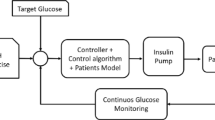Abstract
Type 1 diabetes mellitus is a chronic disease characterized by the increase of glucose in the blood due to a defect in the action or in the production of insulin. For completely autonomous glycemic regulation, a model would be required which permits the future evolution of blood glucose to be estimated. One of the main problems in identifying models is the high variability of glucose profiles both from one patient to another, and in the same patient under not very different conditions. In this paper, we propose a method using an evolutionary algorithm to define the values of the parameters of a minimal model based on standard clinical therapy for a several-day horizon. The algorithm is able to show the trend of blood glucose in a 5-day profile by adjusting the glucose model.





Similar content being viewed by others
Explore related subjects
Discover the latest articles and news from researchers in related subjects, suggested using machine learning.References
Acedo, L., Moraño, J.-A., Santonja, F.-J., Villanueva, R-J.: A deterministic model for highly contagious diseases: the case of varicella. Phys. A Stat. Mech. Appl. 450, 278–286 (2016). ISSN 0378-4371. doi:10.1016/j.physa.2015.12.153
Eshelman, L.J., Schaffer, J.D.: Real-coded genetic algorithms and interval-schemata. Found. Genet. Algorithms 2, 187–202 (1993)
Ono, I., Kobayashi, S.: A real-coded genetic algorithm for function optimization using unimodal normal distribution crossover. In: Back, T. (ed.) Proceedings of the Seventh International Conference on Genetic Algorithms, pp. 246–253. Morgan Kaufmann, San Mateo (1997)
Janikow, C.Z., Michalewicz, Z.: An experimental comparison of binary and floating point representations in genetic algorithms. In: ICGA, pp. 31–36 (1991)
Goldberg, D.E.: Real coded genetic algorithms virtual alphabets and blocking. Complex Syst. 5, 139–167 (1991)
Corcoran, A.L., Sen S.: Using real-valued genetic algorithms to evolve sets for classification. In: IEEE Conference on Evolutionary Computation, pp. 120–124 (1994)
Deb, K., Agarwal, R.: Simulated binary crossover for continuous search space. Complex Syst. 9, 115–148 (1995)
Tsutsui, S., Yamamura, M., Higuchi, T.: Multi-parent recombination with simplex crossover in real coded genetic algorithms. In: Proceedings of the 1st Annual Conference on Genetic and Evolutionary Computation, vol. 1, pp. 657–664. Morgan Kaufmann Publishers Inc. (1999)
Back, T., Schwefel, H.-P.: An overview of evolutionary algorithms for parameter optimization. Evol. Comput. 1(1), 1–23 (1993)
Prud’homme, T., Bock, A., François, G., Gillet, D.: Preclinically assessed optimal control of postprandial glucose excursions for type 1 patients with diabetes. In: IEEE Conference on Automation Science and Engineering (CASE) (2011). doi:10.1109/CASE.2011.6042510
Nelder, J.A., Mead, R.: A simplex method for function minimization. Comput. J. 7, 308–313 (1964). doi:10.1093/comjnl/7.2.155
Herrera, F., Lozano, M., Sánchez, A.M.: A taxonomy for the crossover operator for real coded genetic algorithms: an experimental study. Int. J. Intell. Syst. 18, 309–338 (2003)
Deb, K., Anand, A., Joshi, D.: A computationally efficient evolutionary algorithm for real-parameter evolution. Evol. Comput. 10(4), 371–395 (2002)
Davis, L.: Handbook on Genetic Algorithm. Van Nostral Reinhol, New York (1991)
Yang, J-M., Kao, C.Y.: A combined evolutionary algorithm for real parameter optimization. In: Proceedings of 1996 IEEE International Conference on Evolutionary Computation, pp. 732–737 . IEEE Service Center, Piscataway (1996)
Surry, P.D., Radcliffe, N.J.: Real representations. In: Belew, R.K., Vose, M.D. (eds.) Foundations of Genetic Algorithms 4, pp. 343–363. Morgan Kaufmann Publishers, San Francisco (1996)
Syswerda, G.: Uniform crossover in genetic algorithms. In: Schaffer, J.D. (ed.) Proceedings of the Third International Conference on Genetic Algorithms, pp. 2–9. Morgan Kaufmann Publishers, San Mateo (1989)
Araujo, L., Cervigón, C.: Evolutionary algorithms: a practical approach. RAMA, pp. 111 (2009)
Michalewicz, Z.: Genetic Algorithms \(+\) Data Structures \(=\) Evolution Programs, 3rd edn. Springer, New York (1996)
Acknowledgements
This work was funded by the TIN2014-54806-R, TIN2014-57028-R and MTM2013-41765-P. The authors would also like to thank María-Aranzazu Aramendi-Zurimendi and Remedios Martínez-Rodríguez from the Endocrinology and Nutrition Service at the Príncipe de Asturias hospital (Alcalá de Henares, Madrid, Spain). Abbot has supported this research with the donation of a glucose sensor (Free Style Libre).
Author information
Authors and Affiliations
Corresponding author
Rights and permissions
About this article
Cite this article
Cervigón, C., Hidalgo, J.I., Botella, M. et al. A genetic algorithm approach to customizing a glucose model based on usual therapeutic parameters. Prog Artif Intell 6, 255–261 (2017). https://doi.org/10.1007/s13748-017-0121-9
Received:
Accepted:
Published:
Issue Date:
DOI: https://doi.org/10.1007/s13748-017-0121-9
Keywords
Profiles
- J. Ignacio Hidalgo View author profile




